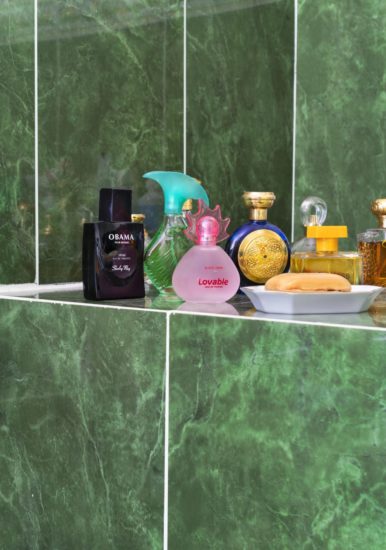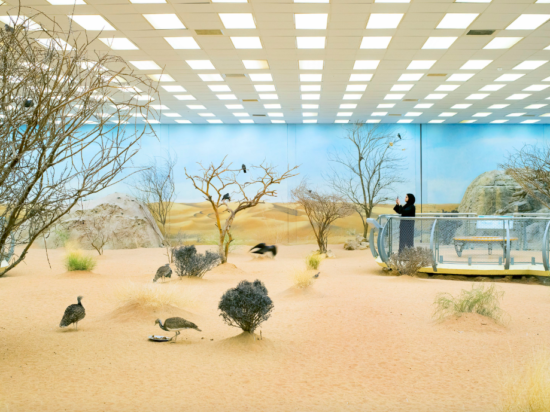This week’s contributing writer, Becca Montante, is a third-year undergraduate student at Northeastern University, pursuing a BLA in Landscape Architecture. She loves making and looking at art.
VoCA is pleased to present this blog post in conjunction with Associate Professor of Contemporary Art History, Gloria Sutton’s Fall 2019 upper-level seminar, Contemporary Art and its Publics. This interdisciplinary course introduces the skills of critical analysis by combining powers of observation — formal description, visual data — with techniques of interpretation to sharpen perceptual awareness allowing students to develop compelling interpretations of visual phenomena within a global context.
When asked to summarize Farah Al Qasimi’s first solo U.S. exhibition at the MIT List Center, curator Henriette Huldisch offered two words: “Camouflage and concealment”. It’s a tidy catch-all for the themes of Farah Al Qasimi’s work, and seems to be the general consensus of others who have seen the show.1 In its wall text, the List asserts that some recent portraits—including A’s Reflection (2019), a ghostly visage reflected in a purple frame behind a vase of orchids, and Living Room Vape (2016), a flash image of a man dressed in all-white, his face obscured by a cloud of vape smoke seated in an opulently patterned living room—capture “moments that feel intimate despite their staging.” But I would argue that it isn’t despite their staging, but rather their lack of staging, that makes them feel intimate.
Al Qasimi has shared, for example, that Living Room Vape (2016) happened because her friend’s uncle was sitting in the living room of her friend’s Abu Dhabi house, when he blew a cloud of smoke as in the image. She asked him to do it again for the photo. The exact moment captured in the photo might be staged, but its surroundings are not. The living room is as is. Similarly, A’s Reflection (2019) is a shot of the artist’s friend in her bathroom. Again, the moment is staged, but Al Qasimi is working with what she has readily available to her, and with what and whom she knows. For me, her work’s intrigue resides in this tension between the staged and spontaneous.
Huldisch presents Al Qasimi’s work successfully at the List Center, evidenced by the breadth of work shown, from video to landscapes to portraits, to the depth of her analysis on the works’ critiques of surveillance and gender roles in the Emirates. In an Alserkal Avenue interview from September 2019, Al Qasimi speaks fondly of her first solo U.S. show at the List: “I’m proud of the MIT show – it is a quiet one, but it lets the work breathe, and the team there was a joy to work with. I like being able to show work in the context of an academic institution; it’s a different audience, there are different questions being asked.” As a viewer, I appreciated Huldisch’s comprehensive curatorial take; among the breadth of work shown shared themes such as an element of spontaneity, were able to emerge.
One photograph that exemplifies such spontaneity is Perfume (Obama, Lovable, Flawless) (2018). Set in the corner of a lustrous, green marble bathroom, a colorful collection of mismatched fragrances, some high end, some not, result in a scene that is high-impact and editorial. The piece is a part of MIT’s Student Lending Art Program, a program that allows MIT students to borrow a piece of art for a year to display in their dorm or apartment. It’s the type of image one might imagine amassing tons of Instagram likes, and not only for the buzzy product labels. Students initially compelled by its bright colors are likely to be charmed upon learning that it’s just a shot of her friend or family member’s bathroom. The lack of formal staging, to a highly aesthetic end, rides the same democratic wave underpinning the appeal of Instagram, and social media in general. It’s a shot that, as a single Instagram post containing a product placement, could earn a top social media influencer thousands of dollars. It speaks to the strength of not only Al Qasimi’s cultural critiques, but her visual language.
All of this she composes at somewhat large, immersive scales that invite close viewing; from a distance, the photos appear fantastical and therefore highly constructed. I was first drawn to Abraj Mall (2018), a multi-story vista, minimal in its clean white surfaces, and yet cluttered. Through a clear curtain of string lights, we view a man in the mid-ground, and a city skyline at sunset, and all of the above through the gently warping ripple of glass. Only upon closer viewing does the scene slowly reveal itself as a mall. My first thoughts were of the electronic music group Empire of the Sun and the brand of slick, fantastical hyper-futurism that I associate with both them and Dubai, home to the world’s tallest man-made structure. That Al Qasimi traverses the same aesthetic territory as a band drawing their inspiration from Alejandro Jodorowsky’s 1973 Mexican surreal-fantasy film The Holy Mountain with something as mundane as a mall photograph, speaks to Al Qasimi’s strength in seeking out just the right moment. The film itself touches on themes she explores in her work, such as consumerism and western cultural exploitation.2 It’s as engaging to consider the social implications of the photo, given that malls provide a more relaxed socializing venue than the streets in the UAE, as it is to chew on how Al Qasimi captured the image in just that way.
Similarly, Aviary (2019) drew me in with its perplexingly constructed desert scene. Small desert plants, dotted in unnaturally awkward isolation on clean sand, stand in front of a wall of blue sky and beneath a metal ceiling lined with rows of lights. To the right, a woman takes a photo of the scene from a metal platform, like you might find in a natural history museum. What at first appeared to be a life-size diorama, or an extraterrestrial terraformed planet, was just a museum. As with the mall, these environments are constructed, but not by Al Qasimi. This tension between the staged and unstaged seem to place her somewhere between contemporaries like Yto Barrada and Shadi Ghadirian. As a dual citizen of France and Morocco, Barrada takes documentary photography of the Strait of Gibraltar, showcasing the city of Tangier outside of western perspectives; Ghadirian challenges women’s gender roles and censorship within Islamic society with staged portraits of veiled women, sometimes in historically-reconstructed settings. Living and working in both New York and Dubai, Al Qasimi seemingly resides between Barrada’s raw, unstaged captures and Ghadirian’s staged portraiture, while investigating similar themes as both artists.
1. Reynolds, Pamela. “Vivid And Lush, Farah Al Qasimi’s Photographs Draw On The Imagination At MIT List.” WBUR. July 25, 2019. https://www.wbur.org/artery/2019/07/25/farah-al-qasimi-photographs-mit-list.
2. Seitz, Matt Zoller. “Modern Life, in All It’s Mystery and Madness.” The New York Times. April 18, 2007. https://www.nytimes.com/2007/04/18/movies/18moun.html.


